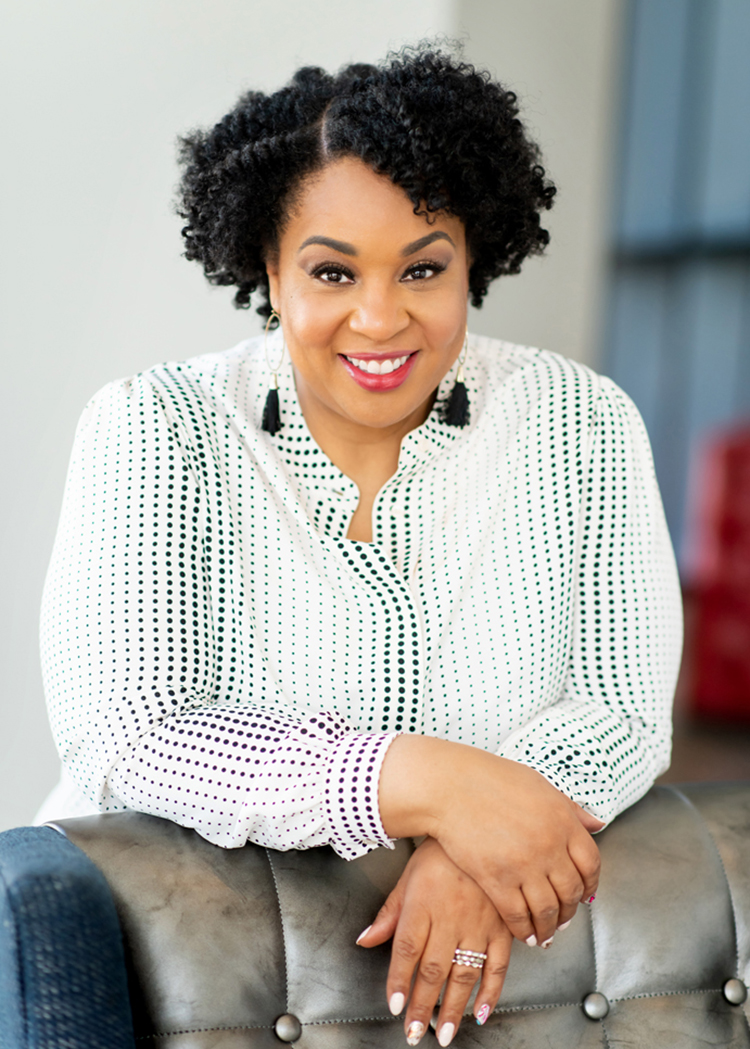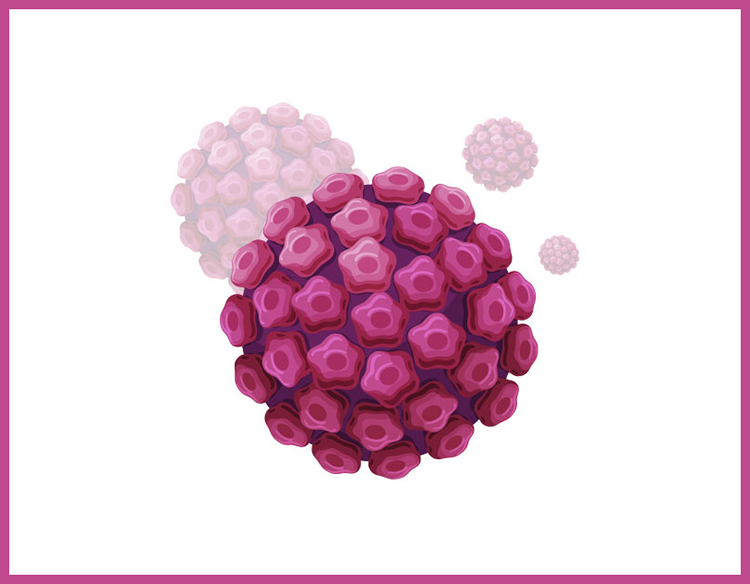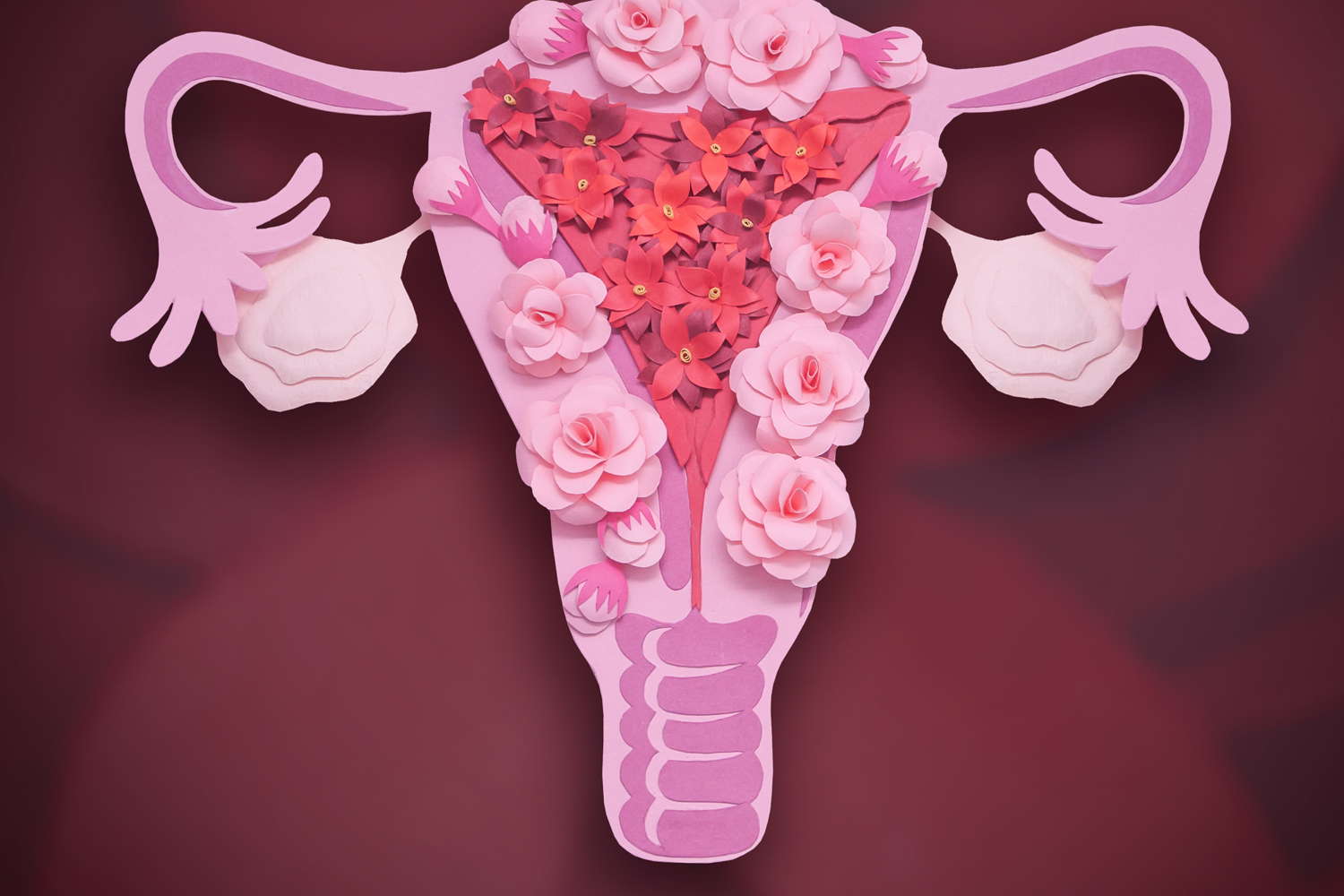TAMIKA FELDER WAS JUST 25 YEARS OLD and working as a TV producer in Washington, D.C., when she was diagnosed with stage II cervical cancer. After a radical hysterectomy, chemotherapy and radiation at Johns Hopkins Kimmel Cancer Center in Baltimore in 2001, the young Black woman had to come to grips with a profoundly altered version of her life—one where she would not be able to become pregnant or carry a child to term.
Twenty-one years later and still cancer-free, Felder is an outspoken patient advocate and the founder of Cervivor, a nonprofit dedicated to supporting fellow cervical cancer survivors. She gives talks, encourages other patients to share their stories and helps give a voice to those who die of the disease.
Felder was diagnosed after a routine screening, one that she says was long overdue. “When I went to see a doctor, it wasn’t because there were any issues,” she says. “Fast forward years later, now I know more about cervical cancer. But at the time, there really weren’t, to me, any warning signs.”
If Felder had been educated about the disease, she says, she might have known something was wrong. She was seeing a small amount of vaginal bleeding after sex, a warning sign for cervical cancer, but she didn’t think anything of it. She was young, healthy and busy, and undergoing Pap tests was low on her priority list.
When Felder was growing up in South Carolina, the cervix wasn’t exactly a frequent topic of conversation. And although she had an excellent oncology team for her treatment once she was diagnosed, she felt she was a target of stigma and shame when she sought second opinions for her treatment course. This was partly because cervical cancer is tightly linked to infection with human papillomavirus (HPV), which is sexually transmitted. This stigma exists despite HPV being so common. In fact, before the HPV vaccine came out, infection with the virus was so pervasive that it was considered a common consequence of being sexually active.
Usually, the body clears HPV infections with no issues or symptoms. But in about 10% of cases, the infection persists. When this happens, the virus can turn normal cells into cancerous ones, especially high-risk strains.
Even before her diagnosis, Felder had experienced shame from a doctor over her weight. In 1999, two years before her diagnosis, she went in for an overdue Pap test. Her doctor, whom she had never met, pressed on Felder’s stomach and said, “You know, if you were pregnant, you wouldn’t know.”
“I was body-shamed as a plus-sized woman,” Felder says. Just 23 at the time, she became so upset that she left without getting the test. “I got in my car, and I cried. I didn’t go back [for a Pap test] until, unfortunately, it was too late.”
Eliminating Cervical Cancer: An Attainable Goal?
Cervical cancer was once a leading cause of cancer death among women worldwide. Fortunately, thanks to Pap tests that screen cervical cell samples for abnormalities that might cause cancer, the U.S. has seen more than a 50% decline in cervical cancer-related mortality in the past four decades.
If caught early and treated promptly and appropriately, cervical cancer has a cure rate of more than 90%. In addition, the HPV vaccine, first introduced in 2006 for girls between 9 and 26 years old and later approved for boys as well, is nearly 100% effective at protecting against high-risk strains of the virus that cause about 91% of cervical cancers.

Tamika Felder was 25 when she was diagnosed with cervical cancer after putting off her routine screening. She started her own nonprofit, called Cervivor, to raise awareness of the disease.
Given the strong measures available, public health experts have set their sights on effectively eliminating the disease. Globally, the most severe burden from the disease comes from middle- and low-income countries. In the U.S., considered a high-income country, more than 14,000 women will develop cervical cancer in 2022, and over 4,000 will die from the disease. This is despite widespread availability of Pap tests and HPV vaccination. “There are still people who die of cervical cancer,” says Felder. “Young moms. Young women who are just starting their lives.”
While wealthy countries have better access to resources than low-income countries, the incidence rate in the U.S. has not budged since about 2007. Incidence is highest among Black and Hispanic women and among low-income and rural populations. In a 2019 study, data from 2010 to 2014 showed that women in the U.S. had higher rates of cervical cancer in rural areas than in urban areas. Yet while white women in urban areas have significantly lower incidence of cervical cancer, Black and Hispanic women have similar rates of cervical cancer in both rural and urban areas. It would seem the systemic barriers that exist for these women in rural areas also exist in urban areas, says Ana P. Ortiz, an epidemiologist at the University of Puerto Rico in San Juan. “In Blacks and Hispanics, living in an urban setting doesn’t seem to be protective.”
The same study showed that significantly more Black and Hispanic women are diagnosed with cancer that has spread to regional and distant areas of the body than white women, regardless of where they live. Overall, Hispanic women are 30% more likely to die of cervical cancer than white women, and Black women are 65% more likely.
“Any time you diagnose cervical cancer, that’s a potential missed opportunity of prevention,” says epidemiologist Mary C. White, the chief of epidemiology and applied research in the cancer division at the Centers for Disease Control and Prevention in Atlanta and a lead author of the 2019 study. “So, we’re looking at potential failures of screening when [we see] these cancers being diagnosed at regional or distant stages.”
More Than Screening
Screening is the key to catching precancers early. The current recommendations are to get a Pap test every three years from age 21 to 65 and/or a high-risk HPV test every five years after a woman turns 30. However, screening is just the first step for cervical cancer care. “For screening to be effective, it has to be done frequently, according to guidelines, and you need to have appropriate and timely follow-up,” says White.
Research suggests that Hispanic women are most likely not to be screened. Their mortality rates are slightly higher than national averages, and their incidence rates are much higher. Black women, on the other hand, are far more likely to die of the disease, despite the fact that they are significantly more likely than white women to be recently screened.
In a 2020 survey, 79% of Black women ages 21 to 49 reported having a Pap test in the prior two years, compared to just 68% of white women and 66% of Hispanic women. Many Black women in Alabama have taken leading roles in getting the word out about screening and prevention, says Jennifer Young Pierce, a gynecologic oncologist and program leader of cancer control and prevention at the Mitchell Cancer Institute in Mobile, Alabama. Yet Black women are still disproportionately dying.
“There’s a grave difference between receiving the screening tests and getting the preventative treatment,” says Young Pierce, describing the need to treat precancerous lesions quickly once they’re detected. She suspects discrepancies in follow-up care for Black women—and systemic bias—are contributing to this higher mortality rate.
In fact, Black women have significantly lower rates of follow-up treatment after an abnormal Pap result. A study published Feb. 1, 2021, in Gynecologic Oncology looked at more than 7,500 women who were part of the 2010 National Health Interview Survey. The researchers found that even though Black women were more likely to get Pap tests, only 78% of Black women reported receiving a follow-up recommendation, compared to 87% of white women in the study. The hard question that needs to be asked, says Young Pierce, is whether providers on the whole work harder to get white women back into the office for treatment. “I worry that this is the case,” she says.
The Role of Biology
Biology may play a part in why Black women see higher incidence rates. Studies have shown that Black women may take significantly longer to clear HPV infections than white women, which could lead to more abnormal Pap tests and diagnoses. Furthermore, a 2018 study found that Black and Hispanic women are more likely than white women to have prevalent high-risk strains not covered by any vaccine. Because HPV 16 and 18 are prioritized for follow-up care, women carrying other strains may fall by the wayside. Another study found that when Black or Hispanic women were infected with HPV 16, the viral genome was significantly more likely to be integrated into their own genome. This is a key step in the development of cancer from an HPV infection.
A woman’s susceptibility to infection, Young Pierce says, is also influenced by chronic stress, which can suppress the ability to fight off pathogens like HPV. Black and brown women, she adds, suffer more greatly from racial prejudice, climate change and pollution. “There are post-birth mutations that occur as a result of the chronic stress of living in a racist society that have a direct and profound link to our immune system and to our risk for disease,” she says. This has serious implications not only for these women’s ability to clear infections, but also for their response to cancer treatment.

Usually, the body clears HPV infections with no issues or symptoms. But in about 10% of cases, the infection persists. When this happens, the virus can turn normal cells into cancerous ones, especially high-risk strains. VikiVector / shutterstock.com
Some have asked whether Black women simply have more aggressive cancers. However, a 2001 analysis of more than 1,500 patients with cervical cancer in a tumor registry for the United States Military Health System showed that when women are the same age at diagnosis, have the same stage of cancer and receive the same care, there is no race-based difference in mortality. That likely indicates that human choices are a factor in real-life differences, not only differences in the disease itself, Young Pierce says.
Uneven Access to Treatment
Barriers to treatment also differ according to a woman’s race. Studies show that Black women are more likely than white women to receive chemotherapy or radiation to treat early-stage cervical cancer instead of a hysterectomy, which is the standard treatment.
Brachytherapy, radiation that is administered internally, is a critical part of cervical cancer therapy. It is intense, invasive and requires a high degree of expertise to be done safely. It also offers a powerful therapy boost by significantly improving tumor remission, five-year survival and prevention of recurrence. While daily visits for external chemotherapy and radiation can often happen closer to home, the last, specialized step of brachytherapy is where health care can fall apart for people with poor access. Studies have found that Black women are less likely to receive brachytherapy, despite its effectiveness for all stages.
“Without it, it’s almost certainly a death sentence,” says Young Pierce. “That component of radiation makes such a significant impact on a woman’s survival of locally advanced cervical cancer in the United States. It’s absolutely unacceptable for a woman to not receive it or not be offered it.” Improving Black women’s access to brachytherapy could help narrow the survival gap, she said.
“At the end of the day, it has to do with socioeconomic barriers,” says Ortiz. As of 2019, over 17% of Hispanics and over 21% of the Black population lived under the poverty line, compared to 9% of whites. Socioeconomic status influences many aspects of everyday life that can make seeking care more labor-intensive—for example, greater difficulty in taking time off from work for appointments, traveling to the doctor’s office, finding suitable and affordable child care, and, of course, paying for it all. Even within minority groups, socioeconomic status is key. “If you have a lot of resources, you can many times overcome these barriers,” says Ortiz. “But if you don’t, you can get lost in the system.”
The medical community needs to work to overcome distrust inspired by past mistreatment of Black people in the U.S.
When it comes to seeking care, cervical cancer survivor Tamika Felder, who is Black, says we have to be willing to explore the generations‑long mistrust between many Black men and women and the medical community.
“The procedures that we know as modern gynecology now, those are procedures that were done on enslaved Black women,” she says. “If you look at that and think about the storytelling from generation to generation of Black women, no one would trust going in and getting a pelvic exam.”
Felder is referring to J. Marion Sims, the “father of modern gynecology,” who performed multiple experimental surgeries on enslaved women in the 1840s in Alabama. For reasons that are hotly debated, Sims performed these surgeries without anesthesia. Indeed, this is one of several well-known examples of medical trauma in Black history, including the story of Henrietta Lacks, whose cancer cells were the source for a cell line used in research, and the Tuskegee study of untreated syphilis in Black men.
Of equal importance, critics say, is that the lingering mistrust resulting from these events is earned anew every time the modern health care system fails to correct systemic imbalances that are happening right now. The continuing disparities in cervical cancer care for Black women are just one example.
Hispanic women with fewer resources also may face language and cultural barriers that can lead to hesitation in seeking health care and an inability of English-only doctors to convey important, complex diagnoses.
Experts are encouraging FDA approval for self-sampling cervical testing swabs that would be sent to people’s homes, complete with prepaid return postage. At-home testing would eliminate the need for transportation, minimize language barriers, accommodate busy schedules and neutralize the fear and stigma many women feel about their gynecological appointments. “That’s going to be instrumental to improve access for these women,” says Ortiz.
Young Pierce says providers and policy experts in the U.S can learn some lessons about how to reach rural patients by looking at programs in low-income countries. Tactics include door-to-door care and providing assistance to get patients to large cancer centers a long distance away. Young Pierce also would like to see more clinical trials that test simple, low-cost solutions to improve health outcomes for rural, low-access areas.
Lack of adequate health insurance is another pain point for many patients. A 2016 study showed that women with no health insurance or those on Medicaid had significantly higher cervical cancer mortality, less guideline-based care, and higher frequencies of late-stage diagnoses than women with private insurance. Both Black and Hispanic women are more likely than white women to be on Medicaid or have no insurance. Among women 64 or younger, 22% of Hispanic women were uninsured in 2021, compared to 12% of Black women and 7% of white women.
A 2018 study found that insurance status accounts for almost 19% of the excess cervical cancer mortality in Black women relative to white women. More insurance availability could help bridge the gap. In September 2010, for example, the Affordable Care Act required private insurance companies to allow dependents to stay on their parents’ policies until age 26 rather than 19. Within two years, this step resulted in a 9% increase in early-stage diagnosis among women in their early 20s.
Another way to improve follow-up care, says Young Pierce, is to use patient navigators dedicated to helping people overcome health care logistical challenges. “This person is paid to make it their job to help [patients] see around the barriers,” she says.
Ultimately, many experts agree that efforts to eliminate cervical cancer can make an impact if they are done right. “We’ve got the tools in place that would enable [elimination] to be a reality,” says White. “We just need to make that happen.” The key, says Ortiz, is for health care professionals and researchers to work together to identify the gaps.
“I look at that time in my life, and I’m so grateful that I made it through it,” says Felder of her experience with cervical cancer. “But there are so many women who don’t make it. I think of their names. Wonderful women that I actually knew, that I was able to touch and hold and hug and make friends with, and they’re no longer here. … There is power in their stories,” she says.
Cancer Today magazine is free to cancer patients, survivors and caregivers who live in the U.S. Subscribe here to receive four issues per year.





